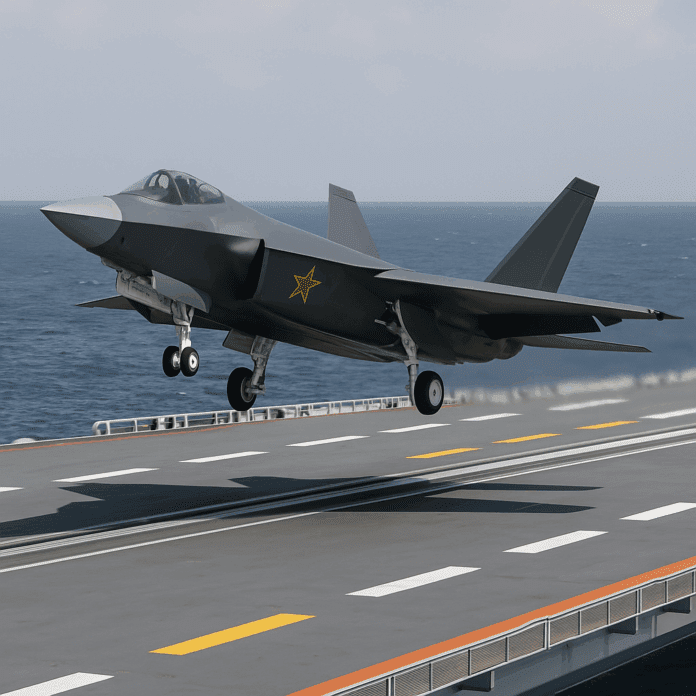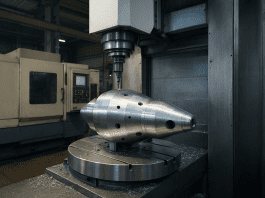In late April, reports started spreading that China’s powerful stealth fighter, the J-35B, may have successfully taken off using an advanced catapult system from the aircraft carrier Fujian (CV-18).
First Signs of a Major Leap
While this information hasn’t been confirmed officially, it has drawn huge attention across the world.
The launch is said to have happened in late March 2025. A known Chinese defense watcher shared this news online, stating that the J-35B had performed its first takeoff using something called an Electromagnetic Aircraft Launch System, or EMALS. This is a modern way to launch planes from ships, using electricity instead of old steam methods.
The Fujian is China’s newest and most advanced aircraft carrier. It is bigger than China’s earlier carriers and uses flat decks with catapults instead of the ski-jump ramps found on older ships. If true, this test could mean China has made a big move forward in building a powerful naval force with advanced flying machines.
Even though China hasn’t officially said anything about this launch, this secret-first, announce-later style is nothing new for their military. China often tests its new weapons or systems quietly and only shows them to the public once they are sure everything works well. This helps avoid any mistakes in front of cameras or at public events.
China’s Bold J-36 Test Sends Stealthy Warning to U.S. F-47 NGAD
What Is the J-35B Fighter?
The J-35B is a new stealth fighter aircraft made to fly from aircraft carriers. It was built to be launched by catapults right from the start, unlike older Chinese planes that were redesigned for this job later. This makes the J-35B stronger and more reliable for these types of launches.
People who have seen the J-35B for the first time often say it looks very similar to another fighter jet used by other countries. This has caused many to believe that the design was influenced by outside information. Despite the controversy, the J-35B has now become a key part of China’s aircraft development programs.
Over the past few months, the J-35B has been seen in many important defense exhibitions both in China and in other countries. It was shown publicly at an air show in China in late 2024 and again in early 2025 at a defense event held in the Middle East. At these events, experts explained that the J-35B is built for aircraft carrier use and has advanced stealth features.
The J-35B was first known under a different name, FC-31. In its early tests, it used engines from another country, but those didn’t work very well. China now says it has developed its own engines for this fighter, and they seem to be working better. If the reports about the EMALS launch are true, then this plane might have cleared a very difficult test.
J-35 Acquisition: Pakistan to Get China’s Stealth Marvel
Why This Carrier Launch Matters
China’s newest aircraft carrier, Fujian, is very different from the country’s earlier carriers. The older ships, Liaoning and Shandong, use a ski-ramp system that limits the amount of fuel and weapons a plane can carry when taking off. These ramps are not ideal for launching heavy or advanced aircraft.
The Fujian uses electromagnetic catapults, similar to the latest technology used by other major naval powers. This system is more flexible and powerful, allowing heavier and better-equipped planes to launch from the deck.
This is where the J-35B plays a major role. It was designed to work with these catapults from the very beginning. It is not a redesigned older plane. In comparison, the J-15T, another Chinese plane, is a modified version of an old Russian design. This older design was never made for catapult launches, and experts worry that its structure might not hold up over time when launched this way.
The J-15T has been reported to undergo tests on the Fujian too, but people familiar with aircraft design warn that forcing an older design to work in new ways can cause cracks or failures in the plane’s structure. This makes the J-35B even more important for China’s future aircraft carrier fleet.
China’s Veiled Warning to US; WZ-9 Drone Could Detect F-35 and B-21
The Fujian itself is estimated to weigh between 80,000 to 85,000 tons, making it one of the biggest carriers in the world. It is also China’s first flat-deck aircraft carrier equipped with three EMALS launch systems. These changes show a clear push by China to expand its naval power with more modern technology.
The J-35B being able to launch from the Fujian means China might be getting close to having a real carrier-based stealth fighter force. Even though there is no official word yet, if this EMALS launch did happen, it marks a major step in China’s military development.







